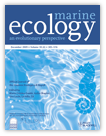Growth Aspects and Magnesium Carbonate Concentrations of the Reef Building Octocoral Heliopora coerulea (Pallas) after Transplantation
Abstract
Abstract. An experiment to test Chave's hypothesis on temperature dependent MgCO3 concentrations in marine calcareous skeletons was undertaken by transplanting colonies of Heliopora coerulea. The corals were transferred from a shallow lagoon with high average temperatures to the outer bottom of a fringing reef, 16 m depth, with low average temperatures. Against expectation, a statistically significant increase of average mol % concentrations from 0.48 to 0.54 % for upper growth regions and from 0.49 to 0.62% for lower growth regions was obtained. Temperature records during the experimentation period and the above data indicate that the mol% MgCO3 concentration in the skeleton of living Heliopora colonies increases when transplanted to an environment with a lower temperature average than that of their original growth site, and with seasonal temperature fluctuations which are smaller in the experimental site than in the control site. Temperature fluctuations at the control site were up to 2.5 times greater than at the experimental site for most of the observation months. This supports the conclusion that the parameters a) minimum temperature and b) temperature stability of the environment are essential for the incorporation of Mg into the carbonate skeleton matrix of marine organisms. Within this study the results of a quantitative chemical analysis of the carbonate skeleton of H. coerulea are presented and growth data of transplanted colonies compared with those from the control site.




